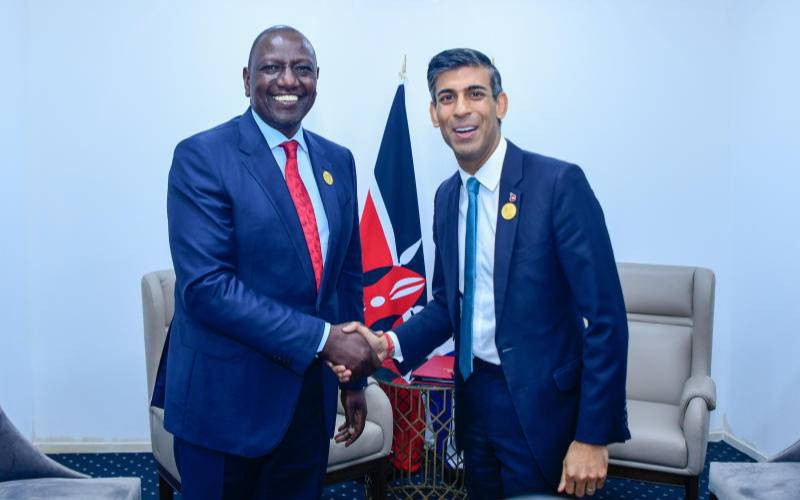
This year's COP27 climate summit in Egypt brings together tens of thousands of participants and more than 100 heads of state to discuss efforts to cut greenhouse gas emissions and ways to cope with a changing climate.
UN Secretary-General Antonio Guterres called for a "climate solidarity pact" between rich and poor nations to limit the severity of global warming during a speech at the summit on Monday.
"It is either a Climate Solidarity Pact - or a Collective Suicide Pact," he warned.
The big picture: Running from November 6 to18 in the Red Sea resort town of Sharm el-Sheikh, COP27 aims to build on last year's Glasgow climate deal as well as 2015's Paris Agreement, but attendees face a sobering reality.
What is COP27?
COP stands for the "Conference of the Parties." meaning those countries that signed onto previous UN climate agreements.
Discussions at this year's COP will revolve around four main topics: mitigation, adaptation, finance and collaboration, according to the summit's website.
Officials have urged countries to commit to plans to further reduce emissions and meet the Paris targets of limiting warming levels to "well below" the 2C mark, with an aspirational target of 1.5C. Studies show that warming beyond 1.5C would have calamitous consequences, such as the potential disappearance of warm water coral reefs worldwide.
Reports published in the run-up to COP27 show the world is on course to warm by between 2.6 and 2.8C (5.04F) by the end of the century in the absence of further emissions cuts.
Many developing countries are calling for more attention and financing to be channelled to measures that can help countries cope with the effects of climate change that are already present. Such measures include creating warning systems for worsening extreme weather events.
Loss and damage to dominate
The summit will feature intense clashes over funding to cover the costs of climate change damages occurring in developing nations, such as the Pakistan floods.
The meeting may, however, fail if countries can't agree on how to move forward on a financing mechanism for what the UN calls "loss and damage" - compensation for vulnerable nations that are being hit hardest by climate change, but contributed the least to causing the problem.
This, as a relatively small group of countries - roughly the G20 nations - are responsible for most of the warming-related impacts.
Developing countries have signaled that they will push hard for a financing mechanism for loss and damage, which is sometimes referred to as "climate reparations," and has been under debate in the UN climate talks since their start in the early 1990s.
"Getting concrete results on loss and damage is the litmus test of the commitment of governments to help close all these gaps," UN Secretary-General Antonio Guterres said ahead of the summit.
Many industrialized nations plan to support the discussion of loss and damage. However, they are skittish about committing to a specific mechanism to pay for it.
This is the situation when western nations have fallen short on previous funding commitments.
A 2009 promise of $100 billion per year for developing country climate aid has not fully materialised.
The US and other industrialized countries have committed to doubling climate adaptation funding, but have yet to follow through.

Where does Kenya stand on loss and damage?
Kenya's climate envoys led by President William Ruto Monday made a strong case on loss and damage.
He said the Horn of Africa region, including Kenya, is experiencing the worst drought in 40 years. Two consecutive years without rain have visited misery to millions of people. That 2.5 million livestock have died in Kenya this year alone causing economic losses of more than $1.5 billion.
The head of state told the delegation that relief food distribution to 4.3 million affected Kenyans has forced the country to reallocate funds budgeted for education and health.
"The trade-offs we are forced to make between indispensable public goods is evidence that climate change is directly threatening our people's lives, health and future," Ruto said.
He explained how drought, has led to many children dropping out of school. "We have been compelled to make school feeding a priority in order to keep children in class."
The country has also had to spend $3 million to supply feed and water to wildlife in the last 3 months due to the ravaging drought.
"As we speak, the pledge made 13 years ago in Copenhagen, committing $100 billion annually, remains unfulfilled. Such egregious and unexplained default is a major cause of persisting distrust. Neither is there any sound reason for the continuing pollution," Ruto stated.
On clean energy the head of state said Kenya has tremendous hydrocarbon and coal deposits which would go a long way in fueling the engines of development. Nevertheless, due to resolute commitment, our electricity grid is 93 per cent green.
Touching on loss and damage President Ruto said a phenomenon of rising water levels in the Rift Lakes was experienced in Kenya in 2020 and generated a humanitarian crisis.
"Approximately 75,987 households were displaced in thirteen counties with a total population of 379,935 requiring urgent humanitarian assistance".
He noticed that Africa contributes less than three per cent of the pollution responsible for climate change, but is most severely impacted by the ensuing crisis.
The reality COP27 participants face
Two major UN reports out last month set a sobering scene for the summit.
The first warned the world is hurtling toward up to 2.8C (5.04F) of warming above preindustrial levels by 2100 barring major new steps. That's way beyond the 1.5C target set by the Paris climate agreement. The second report found that despite calls at last year's COP26 for countries to step up with more stringent emissions plans, just 24 did so.A new report released Sunday found that the past eight years have been the world's warmest on record and the pace of sea level rise is increasing.
Yes, but: There is also some good news. Last year's review of voluntary emissions pledges showed that CO2 emissions would continue increasing after 2030, but that is no longer the case in this year's edition.
Who's attending COP27?
President Biden, as well as dozens of other world leaders, will make an appearance at the summit.
Most high-level speeches are set for Nov. 7-8, though Biden will speak on Nov. 11.Russian President Vladimir Putin, Chinese President Xi Jinping and Indian Prime Minister Narendra Modi are not expected to attend. China is currently the world's largest emitter of greenhouse gases.
Australian Prime Minister Anthony Albanese won't be making an appearance and neither will Canadian Prime Minister Justin Trudeau, his office confirmed to Axios.Worth noting: Prominent climate activist Greta Thunberg announced last month that she would be skipping Cop27, saying that these conferences are vehicles for "greenwashing" and "are not really meant to change the whole system," but rather encourage gradual change.
Protest at COP27
While protests are common at COP summits, the Egyptian government's restrictions on protests and freedom of assembly have prompted concerns.
Egypt's Foreign Minister and COP president Sameh Shoukry promised in an interview with AP in May that protests would be allowed at COP27, saying there would be a "facility adjacent to the conference centre" for such purposes. The protest area is situated "near a highway and away from the conference centre or any other signs of life," the Guardian reported, noting that experts have warned of extensive surveillance during the summit. Activists have already faced hurdles in the run-up to COP27. Many activists from the continent have struggled to secure accreditation and funding to attend what's been the "African COP," Vanessa Nakate, a leading youth climate activist, told Bloomberg Law last month. The Standard Group Plc is a multi-media organization with investments in media platforms spanning newspaper print
operations, television, radio broadcasting, digital and online services. The Standard Group is recognized as a
leading multi-media house in Kenya with a key influence in matters of national and international interest.
The Standard Group Plc is a multi-media organization with investments in media platforms spanning newspaper print
operations, television, radio broadcasting, digital and online services. The Standard Group is recognized as a
leading multi-media house in Kenya with a key influence in matters of national and international interest.

